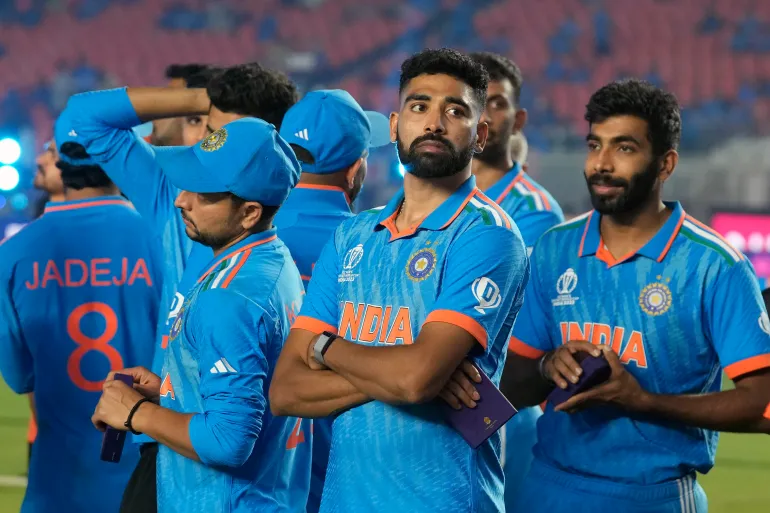
India, despite their dominant performance leading up to the ICC Cricket World Cup 2023 final, faced defeat against Australia, who won the championship for a sixth time. Losing in the final after a flawless run can be disappointing, and there might be various reasons why India faltered in that crucial match. Here are some possible aspects that could have contributed to India’s loss:
1. The toss, the pitch and the conditions
From the moment the pitch was unveiled, all eyes were on the toss and all the chatter was about what the captains would do next.
The late change of pitch for India’s semifinal against New Zealand surprised the game’s experts and played into the hands of the hosts.
The pitch in Ahmedabad for the final was heavily worn – much to everyone’s surprise for an event of such stature.
Would that suit the Indian spinners and the ability of the hosts’ prolific batters through the middle overs? Would it also reduce the impact of Australia’s strike bowlers? Quite the opposite.
The gamble on the surface failed for India – almost from the moment they lost the toss.
Indian fans fell silent when Australia’s Pat Cummins called correctly, but then roared with delight when he elected to field. It’s hard to imagine Rohit Sharma shared the elation of the Ahmedabad crowd. Below are more expanded reasons why the toss was so crucial in hindsight.
2. India’s boundary count
Rohit Sharma went hard at Australia’s seamers with the two new balls from each end and it paid off to an extent. Virat Kohli continued the charge and his three consecutive boundaries off Mitchell Starc at the start of the seventh over looked ominous for Australia.
However, Shreyas Iyer’s dismissal in the 11th over set off a boundary-less period of play that lasted more than an hour and 90 balls.
Kohli was setting himself up in response to the conditions, for he knew India’s hopes of dictating the final rested on him. But when there was a slow pitch and when Cummins’s near-perfect off-cutter got the better of Kohli, the silence in the stadium reflected the nerves of the nation.
Towards the end of their innings, the Indian batters once again failed to score a boundary for over an hour.
3. The Australian quicks
India’s quick bowlers were what many regarded as the reason for the hosts’ dominance and favourites tag before the final.
Mohammed Shami only entered the team in the fourth game, following an injury to Hardik Pandya, but grabbed the headlines with his strike rate.
In the final itself, Australia’s seamers handsomely won the like-for-like comparison. Josh Hazlewood is renowned for his nagging line and length – lethal on a slow pitch. Starc is devastating on any pitch with his skill and aggression as a left-armer. Cummins is the perfect foil for the openers with his change-up of pace.
That was just the start of the India innings. By the end, the ball, scuffed up on the abrasive surface, was reversing and any India hopes of reaching a par score of 280-290 diminished.
4. The spinners
Shami rightly grabbed the headlines, but the economical bowling of Kuldeep Yadav and Ravindra Jadeja was also crucial.
There were indications that India might bring Ravichandran Ashwin on Ahmedabad’s slow pitch, but they didn’t. Could he have played that significant a role in the final?
Meanwhile, Australia’s spinners made good use of the afternoon heat on the slow pitch. Glenn Maxwell picked up Rohit, while Adam Zampa snared Jasprit Bumrah.
Their Indian counterparts showed similar control and economy rates, but went wicketless.
5. India’s seamers
The pitch was not the same for the trio of Indian seamers as it had been for Australia’s seam attack.
The dew, which had saturated Ahmedabad in the days leading up to the game, was not as heavy as expected but the change in conditions under lights was enough to hamper India’s bowlers.
The ball came onto the bat far better throughout the chase and there was enough moisture on the surface from the dew to not have an abrasive effect on the ball. Indeed, even the natural swing early in the innings was not as pronounced as it was at the start of the match.
By the 43rd over, when the winning runs were struck, any hopes that the ball would reverse for India had long passed.
Had India reached a total closer to 300 and the match gone to the wire, perhaps Shami, Bumrah and Mohammed Siraj could have reversed the ball – and the result for the hosts.
Had Rohit won the toss, would this have been a story of five things that went right for India?
Can you be more specific about the content of your article? After reading it, I still have some doubts. Hope you can help me.